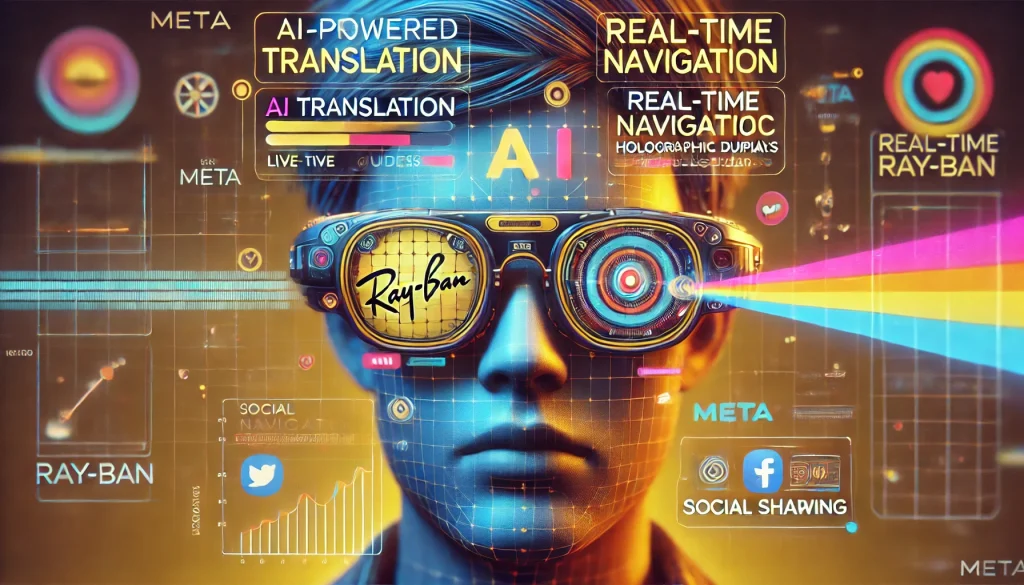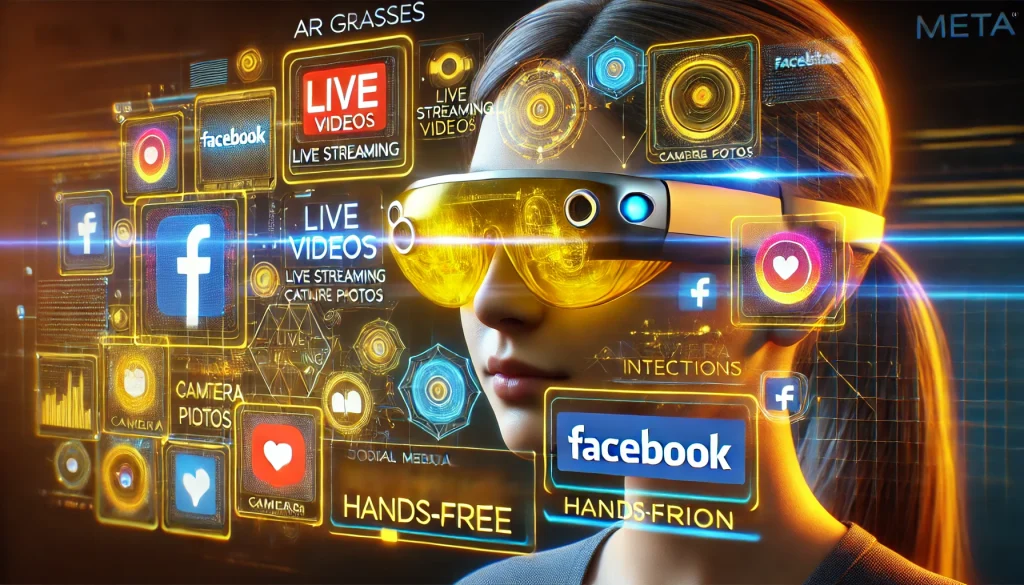Meta’s AR glasses, unveiled by Mark Zuckerberg, blend the real world with digital experiences. Featuring AI translation, holographic displays, and developed in collaboration with Ray-Ban, these glasses offer a sleek, hands-free way to stay connected and interact with your surroundings.
Meta CEO Mark Zuckerberg has once again positioned Meta at the forefront of technological innovation by unveiling a groundbreaking update to the company’s augmented reality (AR) glasses. These next-generation meta glasses are designed to integrate seamlessly into daily life, transforming how we interact with digital content. During a recent interview on the Decoder podcast, Zuckerberg discussed the new Ray-Ban branded AR glasses, their cutting-edge features, and how they will revolutionize our interactions with the world. Meta’s vision for these glasses goes beyond mere display tech—it’s a future of augmented connectivity, social interaction, and productivity.
What are Meta’s AR Glasses All About?
In simple terms, Meta’s AR glasses blend digital experiences with the real world. Zuckerberg’s announcement has stirred excitement because this technology promises to reshape how we see and interact with our environment. But what are they, exactly? AR glasses, unlike virtual reality headsets that immerse users in a fully digital world, superimpose digital images or information onto the real world, enhancing the user’s perception of their surroundings.
Meta’s AR glasses, called Orion, are designed in partnership with Ray-Ban, offering a sleek, stylish alternative to bulkier VR headsets. The idea is simple but powerful: what if you could wear glasses that gave you access to the internet, social media, and digital tools, all within your field of vision? And even better, they’re not just about what you see—they’re about how you communicate, collaborate, and create.
The Vision Behind the AR Glasses
Mark Zuckerberg’s vision for these meta glasses transcends the physical world. The Meta CEO emphasizes that the AR glasses will make it easier for people to stay connected without being glued to their smartphones. “Imagine your phone’s functionality available hands-free, seamlessly integrated into your everyday life,” Zuckerberg said in a recent interview. The technology builds on the ideas set by Google Glasses, but with a far more immersive and social experience.
At the heart of Meta’s AR glasses is its AI-powered voice assistant, which can translate languages in real time, a feature that’s expected to break down language barriers and improve global connectivity. Furthermore, these glasses will enable users to record live videos, navigate directions, and access their social media feeds—all without needing to pull out a phone.
The Overview of AR Glasses: Why This Matters?
The Ray-Ban Meta glasses aren’t just a piece of advanced technology—they are a symbol of where the future is heading. As we increasingly lean on technology to enhance our personal and professional lives, wearable devices like Meta’s AR glasses bridge the gap between human needs and digital capabilities. The glasses make life simpler, smarter, and more interactive without the distraction of constantly looking down at a screen.
With Facebook now rebranded as Meta, this leap into AR territory solidifies the company’s shift toward building the metaverse—a fully immersive virtual world that merges physical and digital experiences. This is not just another cool gadget; it represents a societal shift toward seamless digital integration.
Everything You Need to Know About AR Glasses by Mark Zuckerberg
If you’re wondering what makes Meta’s AR glasses different from other smart glasses or devices, there are several unique points to consider. Mark Zuckerberg has ensured that the glasses aren’t just about displaying digital content—they also offer practical, everyday solutions. Here’s what you need to know:

1. AI-Powered Features
One of the standout features of Meta’s new AR glasses is its use of artificial intelligence. According to Fortune (Mark Zuckerberg Unveils Orion, Meta’s Holographic AR Glasses Prototype), the glasses can perform real-time voice translation, allowing wearers to communicate effortlessly with people who speak different languages. This will be an incredible tool for travelers or businesses operating across global markets.
2. Real-Time Navigation and Mapping
The glasses come equipped with mapping and navigation capabilities. Users can see turn-by-turn directions superimposed onto the real world, which would revolutionize tasks like driving, walking, or exploring new cities. It’s like having a live, virtual tour guide available anytime.
3. Holographic Displays
Meta’s holographic AR glasses bring augmented reality to a new level with ultra-realistic digital overlays, as detailed in CNBC’s hands-on review. This could include anything from seeing digital signs in a foreign country to interacting with 3D objects in your workspace.
4. Content Sharing and Social Features
Similar to the Google Glasses, Meta’s glasses integrate social media into their core design. Users will be able to livestream their surroundings or share short clips with friends in real-time. Imagine watching a concert through a friend’s eyes, all thanks to their AR glasses.
5. Stylish and Wearable Design
With Ray-Ban as a partner, Meta has ensured that these are not just functional but also fashionable. Unlike other tech-heavy designs, these glasses resemble regular sunglasses, making them more wearable in everyday settings.
New Features in Meta’s AR Glasses
As Meta CEO Mark Zuckerberg reveals new features, the future of wearable tech is becoming more exciting than ever. These features combine futuristic tech with everyday usability, making AR accessible to a broader audience. Here are the five most talked-about innovations:
AI-Powered Translation

One of the standout features of Meta’s AR glasses is their AI-powered translation capability. With this technology, users can communicate across different languages in real-time, making travel and global interactions more seamless than ever. This feature is designed to break down language barriers, offering immediate translation without the need for an external device.
Holographic Displays
Meta’s AR glasses come with holographic displays that superimpose digital information directly into your field of vision. Whether it’s directions, notifications, or even 3D objects, these holograms allow for a more immersive and interactive experience, revolutionizing how we engage with digital content.
Gesture Control
These are equipped with gesture control, allowing users to navigate and interact with their device using simple hand movements. From scrolling through apps to making selections, this hands-free feature offers intuitive, seamless control over the glasses without relying on physical buttons.
Seamless Social Media Integration

Meta’s AR glasses integrate directly with popular social platforms like Facebook, enabling users to stream live videos, capture photos, and share content without ever pulling out their phone. This feature enhances real-time interaction and social connectivity.
Ray-Ban Design
Partnering with Ray-Ban, Meta has ensured that these AR glasses not only deliver on functionality but also offer a stylish, wearable design. The glasses resemble traditional sunglasses, making them suitable for everyday use without sacrificing fashion for tech.
Conclusion: Meta’s AR Glasses – The Future of Wearable Tech
Meta CEO Mark Zuckerberg reveals new AR glasses features, and the world is paying attention. The shift from phones to meta glasses could fundamentally change how we live, work, and communicate. While these Ray-Ban branded glasses look cool and are packed with groundbreaking features, they represent something even bigger—the rise of augmented reality as a major part of everyday life.
As Zuckerberg aims to create a world where digital experiences blend with reality seamlessly, Meta’s AR glasses are a key stepping stone toward that future. From AI-powered translation to holographic displays, the future looks both exciting and transformative.
Resources
- Fortune. Mark Zuckerberg Unveils Orion, Meta’s Holographic AR Glasses Prototype
- The Verge. Meta CEO Mark Zuckerberg Discusses Orion AR Glasses and AI
- CNBC. Hands-on with Meta’s Orion Augmented Reality Glasses Prototype
- Livemint. Mark Zuckerberg Unveils Orion: Meta’s Most Advanced Holographic AR Glasses
- Skift. [Ray-Ban and Meta’s Smart Glasses
- Youtube. Exclusive: We tried Meta’s AR glasses with Mark Zuckerberg

